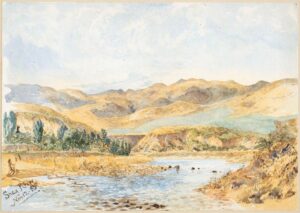1830s: Shag River
December 20, 2022
By AHNZ

There goes another one. Otago’s Shag River now to be re-named with Maori branding.
To colonise New Zealand with state-sponsored neo-Maori, to ultimately change this country’s name to “Aotearoa” it is necessary to make lots of little changes building up to it.
Shag Mouth site was occupied only briefly, about 50 years in the late 14th century, probably 200 years after the arrival of the first people to New Zealand. Goodness knows what these pre-Maori people called the place.
Digs have discovered many bones of moa, dogs, penguins, seals, and fish. No human remains and no weapons or defense structures.
There is no doubt that this site was pre-Maori and certainly a long time before the Ngai Tahu ever set foot on the South Island. No evidence has been presented that this ever was a Maori place although Maoris in the 1850s had a name for it.
According to Sherwood Roberts’ recollections from 1856¹ the Maori name he intercepted was either Waihemo or Waihemu. The first meant “waters passed by,” the second “deadly water.” Perhaps arbitrarily everyone after has taken this as gospel and selected the former as preferable and something to stick into history books as an interesting fact. Waihemo became the name of a locality up the river and even an electorate in the late 1800s.
The names Shag Point and Shag River certainly are legitimate and authentic names that come from the Whaling era of the 1830s. It is possible the name was even established in the 1820s. Our best chance to find that out would be from the diary of Thomas Shepherd when he passed by in 1825 on the first New Zealand Company ship looking to colonise New Zealand. On this off-chance it would be worth consulting Hilda McDonnell (2018.)
Until we know that Maoris even lived at Shag Mouth we only know it as inhabited by prehistoric people based on the archaeology. Why then, you might ask, should Ngai Tahu be consulted with and obliged by re-naming Shag River? This tribe was a very long way from even entering the South Island when those people lived at Shag. And, as far as anyone has said or I can find out, they never did live there themselves. Until the 1836 Battle of Tuturau, far to the south of Shag Point, turned things around for Ngai Tahu the South Island wasn’t theirs any longer. Perhaps the Geographic Board might just as well ask Ngati Toa what they’d like Shag River to be re-named?
“This area was used by the early moa hunters. Nearby, Shag/Waihemo River Mouth yielded important archaeological evidence of Ngai Tahu lifestyles dating back to the 12th century. Moa skeletons and many artefacts found here are displayed at the Otago Museum.” – DOC
“‘Shag’ was an early whaler’s name and the version in local use, and mentioned in historical publications as ‘Shag River’, ‘Shag Valley’, or simply ‘The Shag’. ” – New Zealand Gazetteer
‘‘We wanted to support it because of a desire to recognise our more ancient names,’’ Mr Ellison said…‘‘It’s reflective, informing and educational.’’..‘‘Waihemo’’ translated to ‘‘river that has gone away’’ or ‘‘dwindled’’, and Shag River was named by early whalers as a reflection of the seabird presence, Mr Haanen said.” – Name reflects shared history, ODT (2021)
The State is re-writing our history. Between Te Papa Atawhai and Ngā Pou Taunaha o Aotearoa (that’s DOC and the New Zealand Geographic Board, btw) the truth is being re-jiggered by agenda. The Maorification stresses and excludes contemporary New Zealand stakeholders in order to push them out and make way for a new Conformity group raised in State schools on new, often inauthentic, maps of meaning.
Anarchist History is so important because it divorces Government-sponsored misinformation from what really happened. Nobody needs government compelled speech out of Wellington to tell them what to call their own territory. There should be no “official” compelled names at all but this job left up to individuals. English (and Maori) doesn’t need to to be steered from the Beehive.
—
1 Ref. North Otago Times (1894,) Papers Past
Ref. also 1985: Placing Mt Egmont in the Shade, AHNZ
Ref. also 2018: Government Place Names, AHNZ
—
Image ref. Shag River, Algernon Smith (1885,) Auckland Art Gallery
2 thoughts on "1830s: Shag River"
Leave a Reply
 Like Comment Share
Like Comment Share






One has only to look at who has been a member of – or associated with – the Geographic Names Board since 1985 to understand where the pressure to rename features in the South Island comes from: Stephen O’Reagan. When the first 750 settlers arrived at Lyttelton in 1850 there were under 600 Ngai Tahu in Canterbury. Yet they claim to have intimate knowledge of every rock, stream and feature across a landscape that had no permanent human habitation. I support those who feel that the Ngai Tahu treaty claim was – and remains – a well-planned and thought through scam with a long-term end gae.
I don’t accept they are that clever. Opportunistic.
Everyone’s always trying to colonise each other all the time. We should stop pretending otherwise and let the best ideas win and not have the Government involved in the contest.